VIDEO: Stunning Aerial Footage of Dolphin Family in Zadar Archipelago
February 1, 2021 – The Adriatic might be too cold for us right now, but conditions are perfect for this dolphin family, spectacularly captured gliding through glacial, undisturbed waters by an overhead drone
The Adriatic might be too cold for us right now, but conditions are perfect for this dolphin family, spectacularly captured gliding through glacial, undisturbed waters by an overhead drone
The footage of the dolphin family was captured spectacularly by keen amateur drone photographer Davor Miljkovic. Davor, who is from Zapresic, usually puts his eye for aesthetics into website design – he works as a PHP website developer for Virtus dizajn in Lanište, Zagreb and as a freelance website developer. But, he is currently taking advantage of working remotely and was able to catch footage of the dolphin family during his off time.
“I live in Zapresic but my grandmother is from island Rava, near Zadar,” Davor told TCN on 1st February 2021, two days after he posted the video of the dolphin family to his Youtube channel. “So, we have a house here by the sea. My fiance and I spend part of the winter here and we are here all summer too.”
The Zadar archipelago (in Croatian Zadarski arhipelag) is an incredibly picturesque group of islands off the coast of the city of Zadar. In addition to island Rava, off which Davor saw the dolphin family, the archipelago also consists of the islands Dugi Otok, Galešnjak, Iž, Lavdara, Ošljak, Pašman, Rivanj, Sestrunj, Tun Veli, Ugljan, Vir, Vrgada, Zečevo and Zverinac.
The beautiful stretch of islands is usually very popular with summertime visitors. It would seem that it's also popular in wintertime with visitors who live in the sea. And, of course, people like Davor who are lucky enough to catch sight of them.
For the latest travel info, bookmark our main travel info article, which is updated daily.
Read the Croatian Travel Update in your language - now available in 24 languages
VIDEO: Man Takes His Pet Chicken Shopping in the City Streets of Split
December 10, 2020 – Why did the chicken cross the road? Well, to go to the dućan (store) with his owner, of course! Residents bewildered to see one man taking his pet chicken shopping in the city streets of Split.
Understanding Croatia is often like looking through a kaleidoscope – the closer you look, the more it shifts in and out of the focus of comprehension. Nowhere is that more true than in the seaside city of Split.
Visitors are not the only ones to see this. Split's inhabitants know it too. Despite its reputation for the unorthodox, happenings in Split are still capable of raising the eyebrows of those who live there. And, that was certainly the case a couple of days ago, when residents of the Gripe neighbourhood were bewildered to see one man going shopping accompanied by his pet chicken. Their casual walk to the shops, which sees the pet chicken being led on the kind of leash you'd more usually find on a dog, was captured on video. It is one of the more curious chick flicks TCN has seen this year.
Gripe in Split is a family neighbourhood, known for its sporting facilities and the old fortifications which lie on the hill after which it is named. Even in times of social distancing, it's not uncommon to find neighbours milling around, chatting to each other on a weekend morning. Their idle gossip was given egg-stra fuel on Saturday when the man and his pet chicken made their remarkable hen-trance.
As the weather across Croatia turns colder, this is the traditional time for pigs to be turned into the sausages and bacon that will last through the winter. The chickens and turkeys are safe for now, although only for another week or so. Perhaps this timing egg-splains the walking of the pet chicken? Maybe the owner didn't want to let the prize bird out of his sight so close to Christmas? Or perhaps, given that a camera seems to have been at the ready to film their exploits, the walking of the pet chicken was just a welcome moment of tomfoolery? Whichever it may be, the footage does have an endearing quality. Poultry in motion, if you will.
Spellbinding Waltz of Dancing Springtail: New Species Discovered in Krka
December 3, 2020 – New species, the Dancing Springtail has been videoed performing the fascinating and unique dance from which it takes its name. This recent discovery is so far absolutely unique to one quiet corner of Croatia's Krka National Park
It takes all sorts to make the world. In modern-day America, this is more usually said 'It takes all kinds to make the world go round'. But, this famous saying is older than the United States of America. It comes from the Spanish novel, Don Quixote, published in 1605 and written by Miguel de Cervantes - 'de todos ha de haber en el mundo' (literally, 'there must be of all [types] in the world'). Nowhere is this historic phrase more applicable than in biodiversity.
Bugs are often not the prettiest of creatures. We really don't like it when they come into our homes. But, as TCN learned in our recent article on Stinky Martin aka Smrdljivi Martin, every indigenous species has a role to play in our ecosystems. No matter how unsightly, every bug has its rightful place.
The Dancing Springtail, discovered living in a micro-section of Krka National Park, is not beautiful like a butterfly. Its silver body displays no bold colours capable of catching the eye. But, it does have its own mesmerising dance. And, so far, it is absolutely unique, not only to Croatia but to one tiny corner of Krka National Park.
Observed and recorded in video two years ago, the Dancing Springtail has now been classified and given its own name - Lepidocyrtus chorus, the second word pertaining to the curious waltz the Dancing Springtail is seen to do. Thought to relate to its feeding, diet and possibly digestion, the Dancing Springtail makes a circular movement with its abdomen, while keeping its head in one position. It rotates in both directions. This dancing movement is unique to this Croatian sub-species.
The Dancing Springtail was spotted and specimens collected from the old stone steps in the area of HPP Miljacka in Krka National Park. The stairs are usually damp, partially covered by overhead trees and overgrown with lichen and moss. This particular area of the Krka river canyon, around the Miljacka waterfall, is of exceptional importance to Krka National Park, due to the mix of caves and water features which occur there and the biodiversity within the area. For these reasons, this area is off-limits to the public. The Dancing Springtail has, so far, been seen nowhere else in the world.
The body length of the Dancing Springtail, minus the head, is 1.7 mm. The top of the body is covered with silver scales, but upon closer inspection, it has dark purple spots on the sides of its fourth abdominal ring. On its head, between the antennae, there is a purple-colored patch, roughly in the shape of a triangle.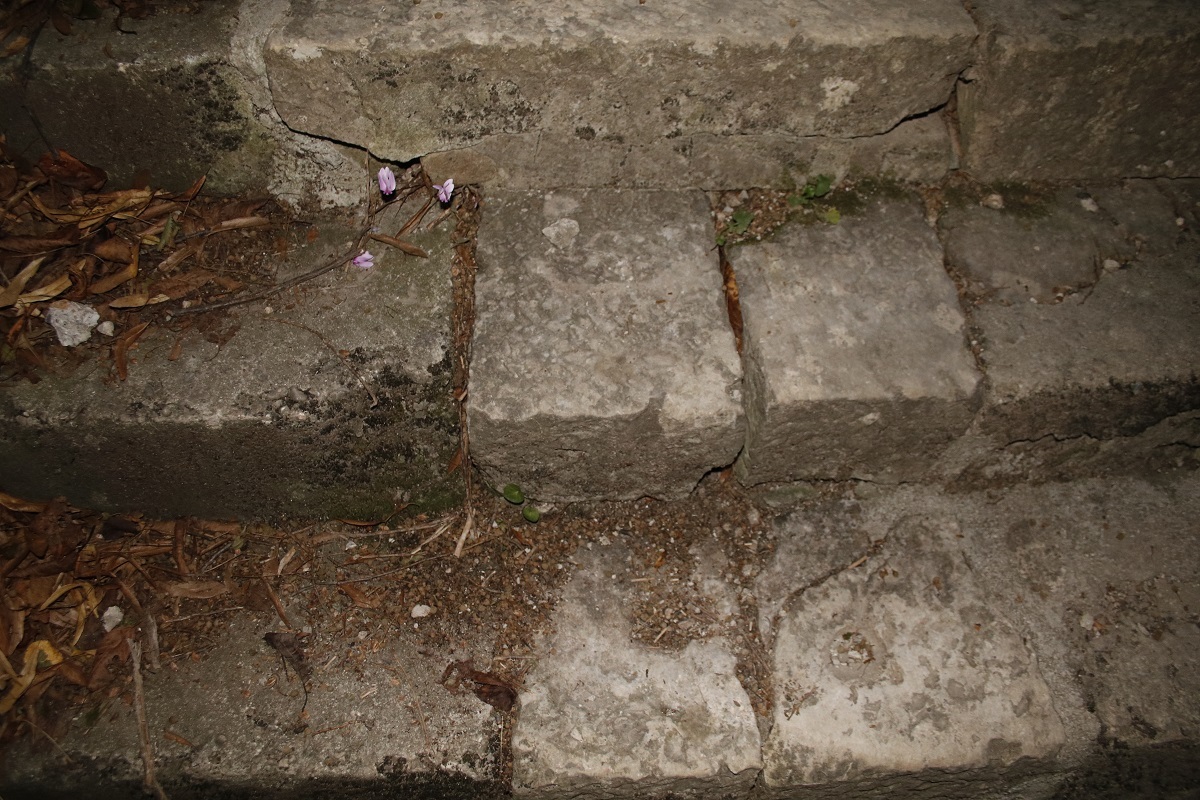 The steps near the Miljacka waterfall where the Dancing Springtail was discovered © Krka National Park
The steps near the Miljacka waterfall where the Dancing Springtail was discovered © Krka National Park
The Dancing Springtail is a sub-species of a wider family of hexapods known as Springtails or Collembola (Skokuni, in Croatian). These bugs are no longer classed as insects, because their mouths are internal, rather than exposed. There are about 3,600 different species of Springtails. They have been observed to feed on leaf litter, fungal hyphae, spores, pollen, animal remains, colloidal materials, minerals and bacteria. In doing so, they assist the decomposition process of natural areas. They are reputed to be one of the most abundant of all macroscopic animals, with estimates of 100,000 springtails living in every square metre of ground. Anywhere there is soil, you can dig and surely find them.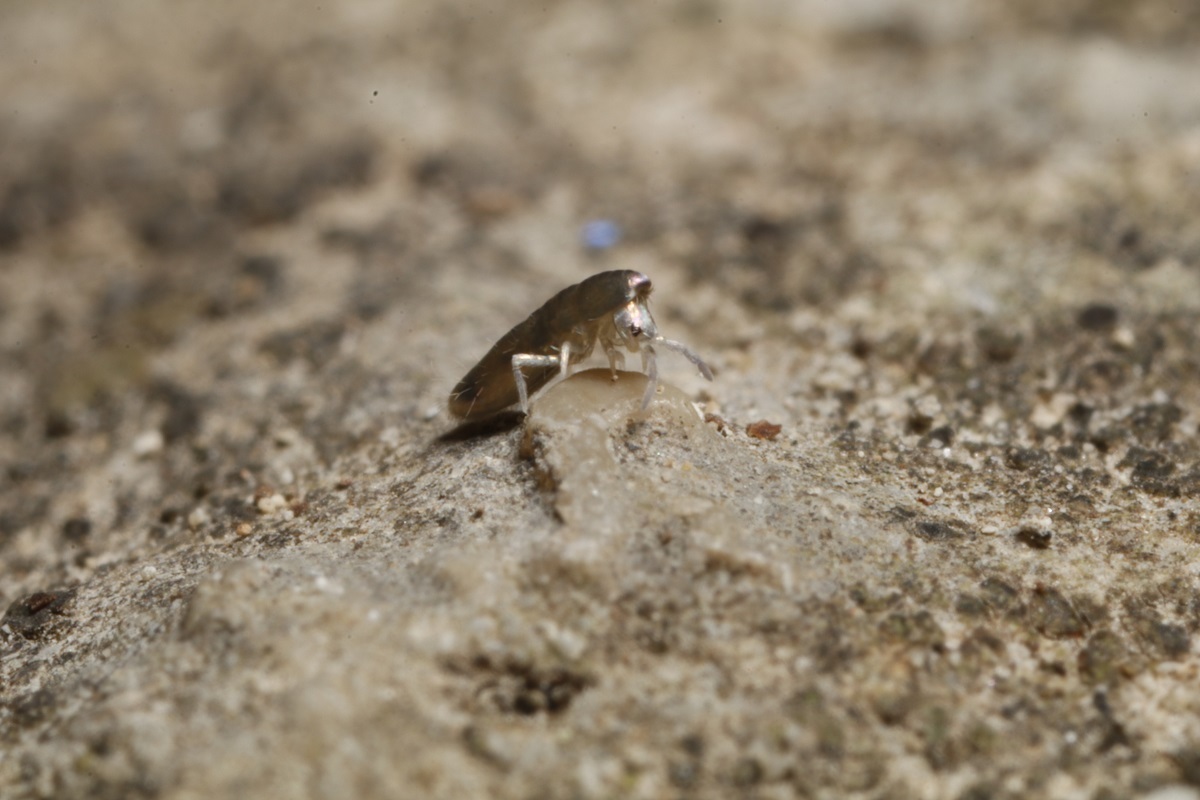 A Dancing Springtail © Krka National Park
A Dancing Springtail © Krka National Park
Springtails get their name from an appendage they have on their abdomen which is held under constant tension. When released, the appendage allows them to fling themselves high through the air in as little as 18 milliseconds. They use this jump as a defensive mechanism and in order to migrate to fresh feeding grounds. The appendage makes springtails one of the best jumpers on the planet.
Springtails possess the ability to reduce their body size by as much as 30% in response to rising temperatures in their environment. Warmer conditions increase their metabolic rates and so the decreasing of their size helps them survive. Springtails are good bio-indicators of soil quality and are currently used in laboratory tests for the early detection of soil pollution. Rumours persist that the United States investigated weaponising springtails for use in biological warfare, indeed that they were used for such a purpose in the Korean War. No widely-accepted proof of this usage exists.
Via the study of fossils, we know that springtails have been on the planet for at least 400 million years. If the Dancing Springtail of Krka National Park has been around for that long, its unique movement is probably the longest-running dance in the world.
Reality TV Star Jasmin Raises Orphaned Fox as Family Pet
December 1, 2020 – 22-year-old Jasmin Kunišinac, a former contestant on the reality TV show Farma, is raising an orphaned fox in his family home. The pair are local celebrities in Vinogradci, near Valpovo, Slavonia, thanks to their walks around the village, and also quite the hit on social media too
It's not unusual for Slavonian people to feel connected to the land and nature which surrounds them. The rich soils of the Pannonian basin in east Croatia often provide an occupation for at least one family member. Certainly, these soils will put food on the family table. The family of 22-year-old Jasmin Kunišinac, who live in Vinogradci, just west of Belišće and Valpovo, is no different. Jasmin's always felt connected to the land.
You could tell as much from Jasmin's 2018 appearance on the Croatian reality TV show, Farma. Upon entering the show, he was described as not lacking experience of life in a rural village. Viewers were told that, in his free time, Jasmin liked to ride, fish, hang out with friends and help abandoned animals. He said his favourite animals were horses and foxes.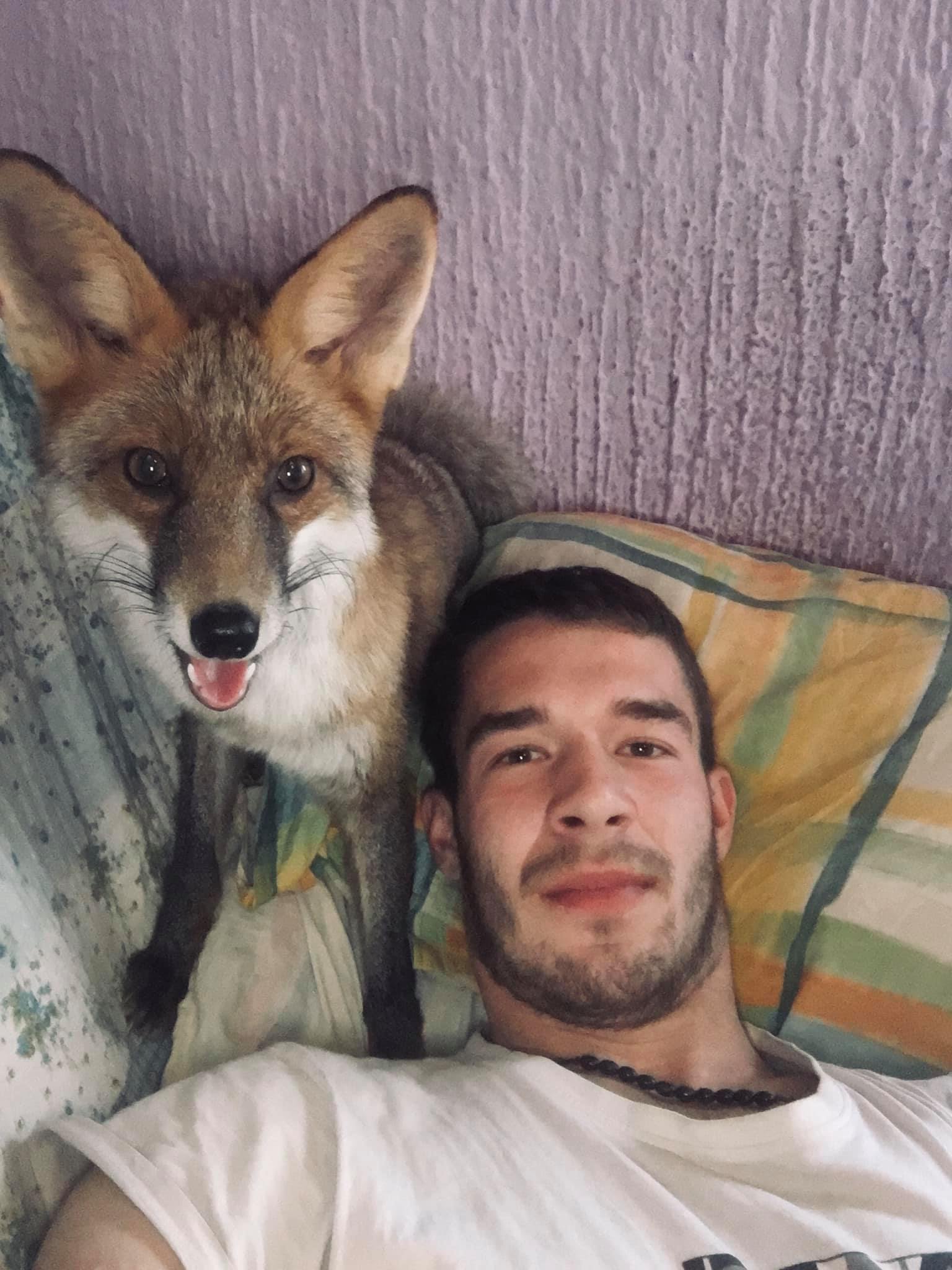 Jasmin and Odi
Jasmin and Odi
Since early 2020, Jasmin's fondness for foxes has been evident for the 250 or so residents of Vinogradci to see, as he has taken on responsibilities for an orphaned fox. Villagers see him taking the fox, Odi, for walks around Vinogradci on a lead.
Vinogradci is focussed around three small streets, down which Jasmin and Odi walk. The houses are narrow at the front, elongated and stretching back away from the street. Behind them, long gardens stretch even further, often containing vegetables, fruit trees, animals or additional buildings for food production. The name of the settlement itself means 'vineyards'.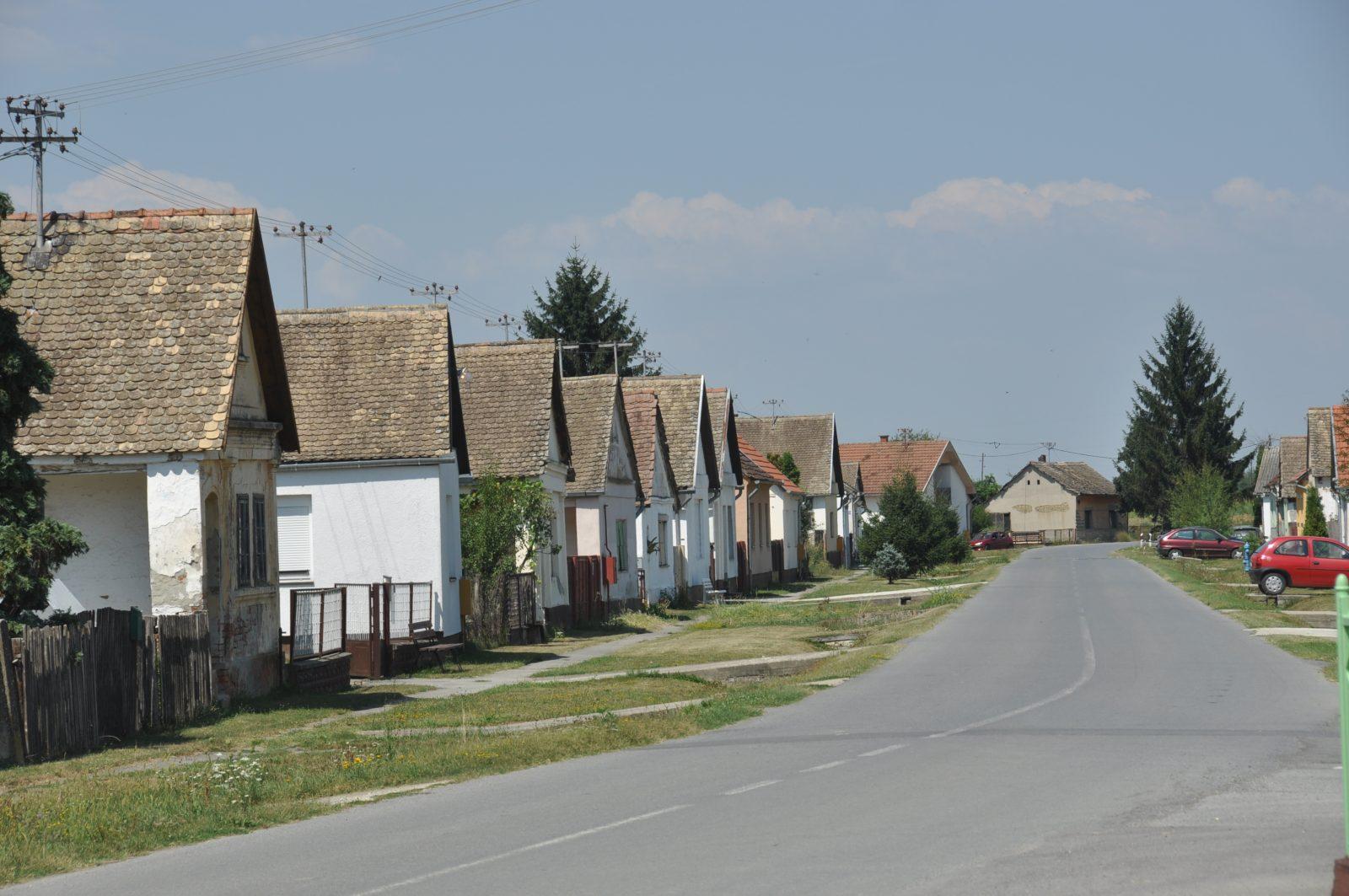 The quiet streets of Vinogradci, where Jasmin takes his fox Odi for walks © Grad Belišće
The quiet streets of Vinogradci, where Jasmin takes his fox Odi for walks © Grad Belišće
It is exactly the sort of land where wild foxes like to roam. By those who keep chickens on their land, these foxes are not always welcome.
Jasmin and his cousin found Odi by the side of the road at the beginning of the year. The pair had been cycling to their grandmother's when they came across the fox cub who, at that time, was no more than a couple of months old. They found the remains of Odi's mom not far away. She had been shot.
The pair decided to take Odi home and fed the fox with milk from a bottle, in much the same way you might a baby child. Jasmin's mum was less than thrilled. Her's is a household already quite full. As well as mom and dad, Jasmin has three sisters and a brother at home. And that's without even mentioning the other animals they have.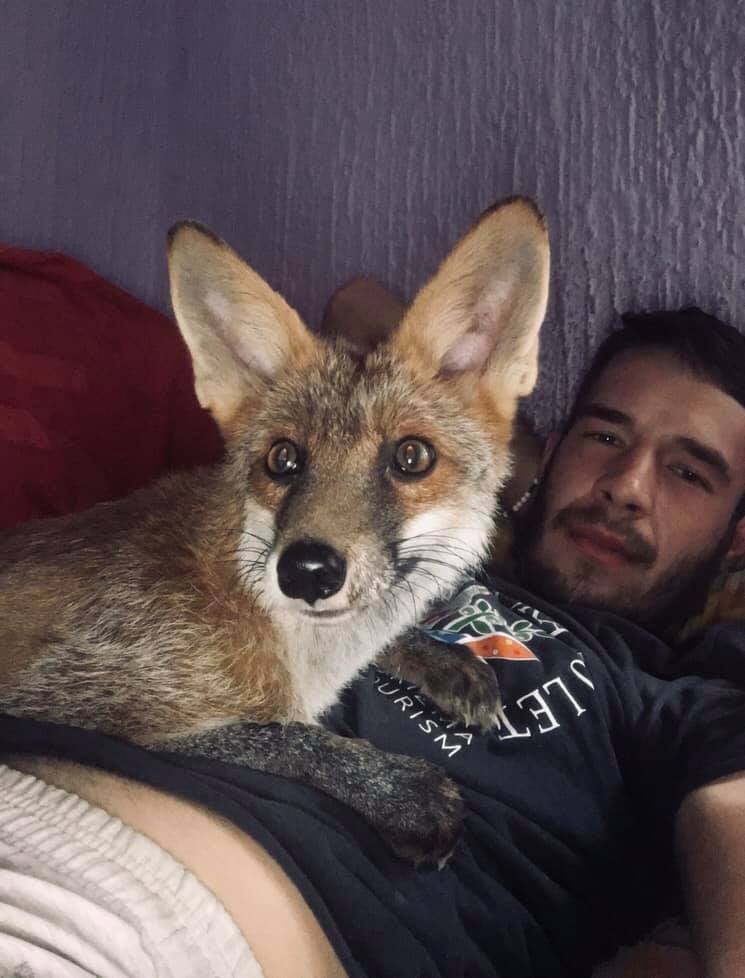
Thankfully, as Odi has become domesticated, he seems to have fit in with family life. He plays with the Kunišinac's Rottweiler and even their chickens seem to have got used to the sight of him. Jasmin's six-year-old sister particularly loves playing with Odi, who is more lively as the daylight begins to fade - foxes are nocturnal animals.
Odi and Jasmin are not only celebrities thanks to their walks around the quiet streets of Vinogradci. Thanks to folks' familiarity with Jasmin on the reality show, Odi has become quite the hit on social media. In addition to Jasmin acquiring more followers on Facebook thanks to the fox's arrival, Odi has attracted some 18,000 views on TikTok.
This is not the first fox that the Kunišinac family have taken in either. Jasmin's dad found one while he was out fishing, which they cared for before he left to be cared for at the zoo in Nasice. Given the foxes fondness for the fields around Vinogradci, there's no telling if Odi will be the last fox to be taken into their home. Who knows, the Kunišinac family and their foxes might create a long-running rural series as popular as Farma.
All photos taken from Jasmin Kunišinac Facebook
Philosophy Faculty Osijek Croatia's First To Welcome Students' Dogs
November 29, 2020 – With most of the staff being dog owners, Philosophy Faculty Osijek has made the decision to become the first university institution in Croatia to which students can bring their pet dogs
The singular city of Osijek is well known for many reasons – the fantastic food of Slavonia and Baranja, the spectacular Old Town of Tvrđa, the Drava river along which the city stretches, one of the current top teams in the national football league and a university that produces excellent graduates in many different subjects, not least computer sciences.
In 2020, Osijek University has been earning a name for itself among the dog-lovers of Croatia. Ivana Kramer, a dog-owner and dog shelter volunteer, this year became Croatia's first animal rights lawyer after graduating from the Faculty Of Law at Osijek University. And Philosophy Faculty Osijek stands as the only such institution in Croatia that students can come to with their pet dogs.
“The decision to become pet friendly was made by the Faculty Council, and according to these rules, animals entering the building must be accompanied by their owners, on a leash or in a transporter,” Vice-dean of Philosophy Faculty Osijek, Milica Lukić told Jutarnji List journalist Zrinka Korljan in an interview published 27 November. “Also, the owners at the gatehouse report the animal they are entering with, say how long they intend to stay and show an ID card. When leaving the building, they report to the gatehouse again so that we have information that the pet has left the faculty space.”
Philosophy Faculty Osijek has been allowing dogs to attend for two years now. Pets can't actually go into class with their student owners, but they can accompany them to the library. During lectures, the dogs have their own space where they can wait. Water and dog food is provided at the faculty entrance.
Other reasons prompting the decision to open the Philosophy Faculty Osijek to pets were that most of the staff were dog or cat owners and that it was noticed attendees who made short visits to the faculty were forced to tie up their dogs outside. Though the Jutarnji List interview also mentions cats in addition to dogs, no mention is made of provisions for students with more exotic pets such as snakes or tarantulas. Perhaps that's going a little too far. Being the only faculty in Croatia that welcomes dogs is maybe good enough for now.
Sailor from Vis island finds a Crocodile on his Boat
November 27, 2020 – Vis islanders are these days not surprised to receive guests who come from all over the world, but the mysterious arrival of a crocodile has raised eyebrows and caused big-teethed smiles
For thousands of years, the inhabitants of Vis island have led a comparatively unharassed existence. They fished in the richly stocked waters that surround them and planted vines and other crops in the island's soils, such day-today activities unaffected by whichever empire decided to lay claim to the rock. Being the inhabited island which lies furthest from the Croatian mainland might have contributed to so many carefree days. That's not to say that nobody ever goes there.
Today a popular tourist destination, over the last few decades Vis island has welcomed visitors from all over the world. Although, the latest exotic arrival doesn't look to have come by budget airline. Found on a boat near the village of Brgujac, a young crocodile has caused bewilderment among island residents over recent days.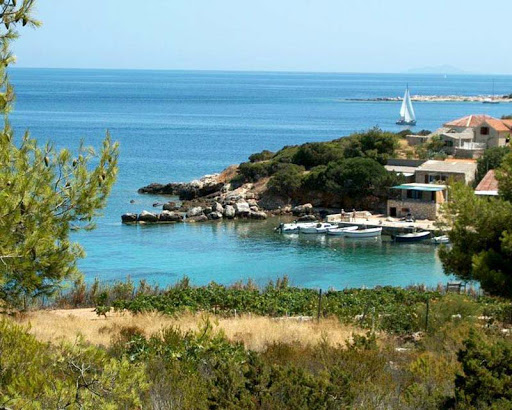
Brgujac. The epicentre of Vis island's punk-croc scene? © Tourist Board island Vis
Snapped on the waterfront of Brgujac and posted to the Facebook group 'Moj otok Vis (My island Vis)', the uncommon visitor has raised both eyebrows and merriment. Nobody is quite sure how the crocodile got here, not least the sailor on whose boat the crocodile was found.
Nobody knows of anyone keeping a crocodile as a pet on the island. The sailor and his boat haven't travelled anywhere that far over recent weeks. Vis island's long distance from the Croatian coast does theoretically place it closer to the African continent, where a crocodile might be more naturally found. But it's only relatively nearer. Africa is still over 1500 kilometres away. This youngster doesn't look to be capable of making such a swim. And, besides, although some do live in saltwater - most crocodiles prefer to spend their time in freshwater.
While the mystery of where the young crocodile came from is being solved, he's been taken off the sailor's boat. The crocodile was initially placed in the care of workers from the municipal company Gradina.
Interview: In Defence Of Stinky Martin aka Smrdljivi Martin
November 12, 2020 - Named after St. Martin's Day, when we most often encounter them, the bug known as Stinky Martin aka Smrdljivi Martin has a bad reputation. But, according to Lucija Šerić Jelaska, a doctor in the Biology Department of the Faculty of Science at the University of Zagreb, such a reputation is undeserved.
So usually pleasant is the weather in Croatia that it's not uncommon for home windows to be flung open in spring and rarely closed again until mid-late autumn. When we finally do so, we're looking to escape the increasingly chilly conditions outside. We're not the only ones who want to come in from the cold.
Some animals hibernate over winter, others just seek somewhere a little more sheltered. In autumn, a few spiders and insects can unwittingly enter homes through open windows on their search. Named after Saint Martin's Day, which takes place on 11th November, Stinky Martin aka Smrdljivi Martin is the most discourteously named bug to do so.
“Stinky Martin aka Smrdljivi Martin belongs to a family known as stink bugs or shield bugs,” explains Lucija Šerić Jelaska PhD to TCN. Lucija is a doctor of science who works as a researcher in the Biology Department of the Faculty of Science at the University of Zagreb. “They all have glands that produce a pungent or unpleasant spray when disturbed or threatened. It's a form of protection from predators.”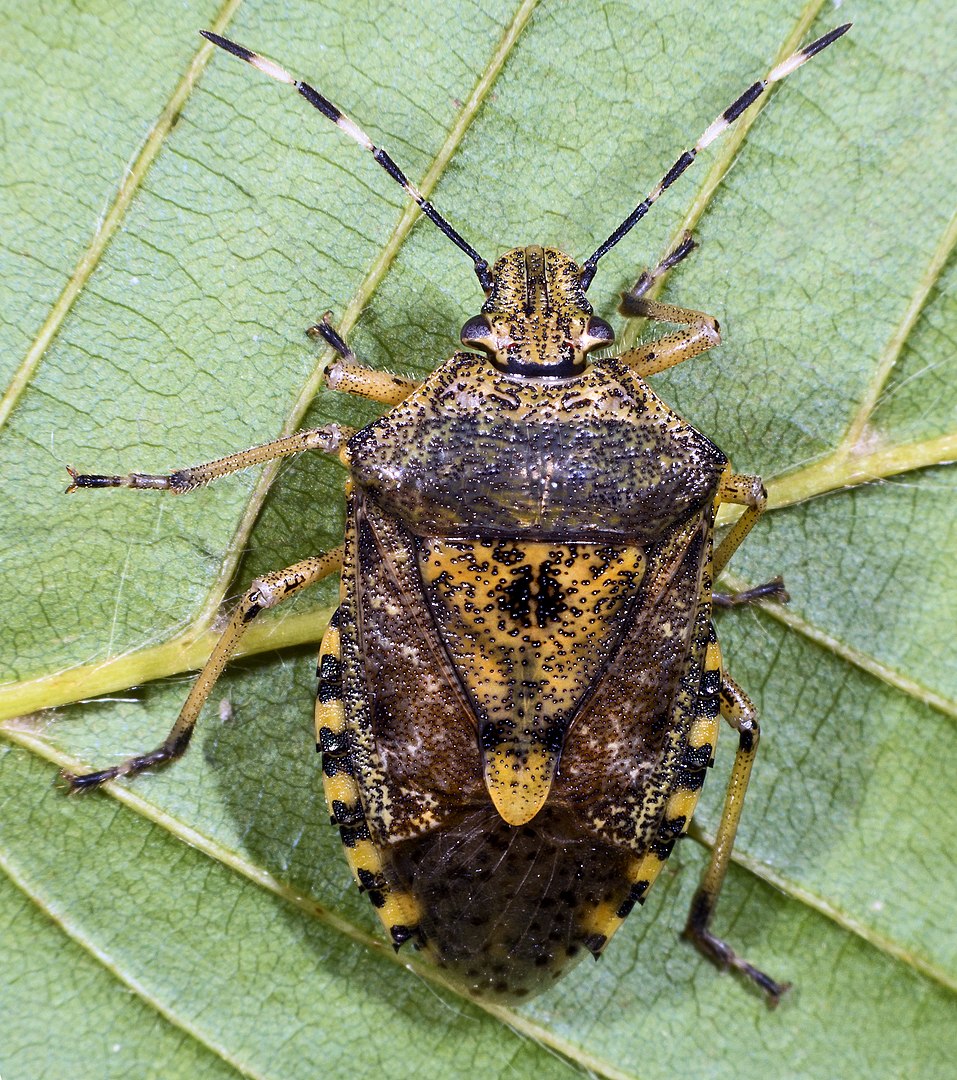 Smrdljivi Martin © Didier Descouens
Smrdljivi Martin © Didier Descouens
“It is not a species specific to Croatia - Smrdljivi Martin is just the common name here for a bug that is found all over Europe,” says Lucija of Rhaphigaster nebulosa (Latin) or the Mottled Shieldbug (English common name). “They like warm and humid climates and so, in winter, they go looking for places to escape the cold. Sometimes it's leaf litter. Other times, it can be the cellars of buildings or people's homes. Around Saint Martin's Day it's becoming colder and so we come into contact with Stinky Martin aka Smrdljivi Martin more often, but actually, they are around outside all the time.”
Insects are unwelcome guests in our homes. But, despite their ghastly name, Stinky Martin aka Smrdljivi Martin are relatively harmless. They move quite slowly. They also fly slowly and clumsily, emitting a low humming noise when they do. They can easily be caught and removed from the home. They can be kept from entering by the same nets we use to keep out mosquitoes, or by closing the windows in our cellars. And yet, perhaps because of their memorable name, mentioning them or catching sight of the often produces the screwing up of faces in disgust.
“Well, they are not beautiful like butterflies or big, shiny, colourful beetles,” laughs Lucija, “and the smell doesn't help. But, they are not considered a pest. When they group together in large numbers, then they can be a pest. People don't like to see them in their orchards or gardens because they can damage the fruit.”
“They mostly feed on plants. The have a long, piercing mouthpart which they use to suck sap from plants. The scars they leave on some fruits by doing this can be attacked by fungi and that can ruin the fruit.”
The defensive spray of Stinky Martin aka Smrdljivi Martin can easily be avoided and, truth be told, aside from very rare and minor allergic reaction, it's not much of a bother if it does catch you. You can simply wash it off, change your clothes. And the smell really isn't that bad.
“Winemakers don't like stinky bugs,” explains Lucija, detailing the few who can be most detrimentally affected by Stinky Martin aka Smrdljivi Martin. “They can hide between the leaves and even the grapes. If enough of them enter the wine production, that wine can have a strange smell and flavour because the bugs contain chemicals like aldehydes and alkynes, sometimes even cyanides which pollute it.”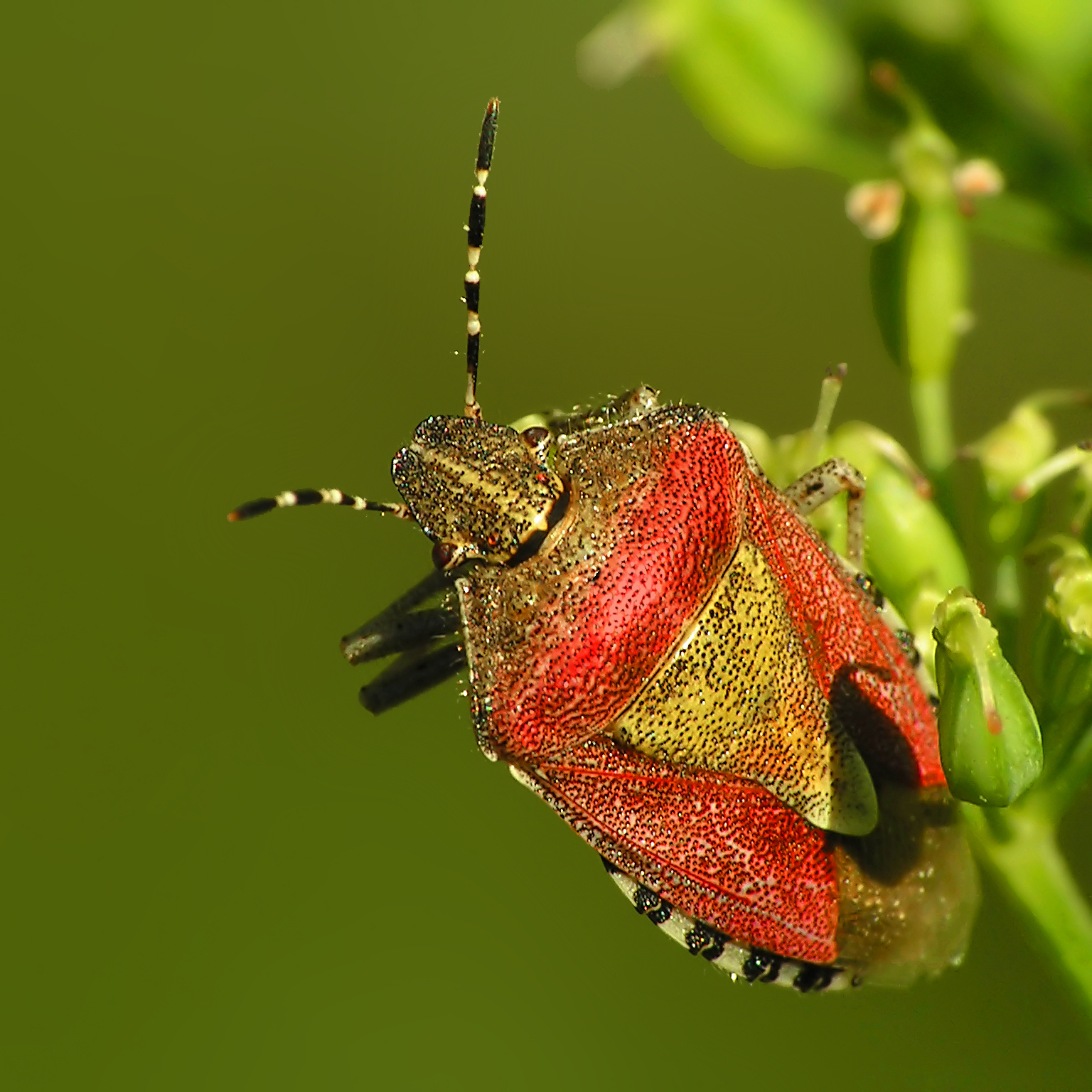 "Smrdljivi Greta is another European shield bug species common to this area and also in Asia. You can find it in hedgerows, fields, parks, gardens. I don't actually know how she got the common name Greta. Unlike Martin, who is a rather dull brown in colour, Greta's colour can be quite bright and variable. It is usually a reddish-purple. I'm speculating, but maybe it was given a female name because of the colour and it was supposed this bug was a female counterpart to Smrdljivi Martin? Of course, they cannot consummate such a relationship - although similar in appearance, they are different species." Photo © Dominik Stodulski
"Smrdljivi Greta is another European shield bug species common to this area and also in Asia. You can find it in hedgerows, fields, parks, gardens. I don't actually know how she got the common name Greta. Unlike Martin, who is a rather dull brown in colour, Greta's colour can be quite bright and variable. It is usually a reddish-purple. I'm speculating, but maybe it was given a female name because of the colour and it was supposed this bug was a female counterpart to Smrdljivi Martin? Of course, they cannot consummate such a relationship - although similar in appearance, they are different species." Photo © Dominik Stodulski
Despite not being welcomed by homeowners and cultivators, Stinky Martin has been here probably for longer than humans have. “They are a natural part of our ecosystem,” says Lucija, defending the bug's residency. “They are food to predators that feed on bugs, such as birds, spiders, some amphibians and other insects. The insects that feed on stinky bugs can be important in biological control, because of the other pests they feed on. Stinky bugs don't necessarily just eat the plants we like either. They could have a role to play in regulating the population of some weed plants.”
The most annoying encounter we regularly have with Stinky Martin aka Smrdljivi Martin at this time of year is on the washing line. Woe betide anyone who leaves freshly washed bedsheets to dry overnight outside in November. Depending on where you live, by the morning, many shield bugs could have crawled between the layers of your sheets, looking for shelter. If you're a bit squeamish, they can make for an awful surprise when appearing in larger numbers. However, if that's something you have seen, you probably shouldn't blame Stinky Martin.
“Those are very likely not Smrdljivi Martin,” explains Lucija. “They simply do not exist in such numbers to be able to invade our homes and lives like the bugs that you and I must remove from the sheets on our washing lines. There is a newcomer that has been causing problems across Europe over the last few years. It is an invasive brown marmorated stink bug, originally native only to Asia. It strongly resembles Smrdljivi Martin. But, there is a big difference. Smrdljivi Martin is a native species. It has been part of our ecosystem for thousands of years. It has natural predators and parasites which control its population.”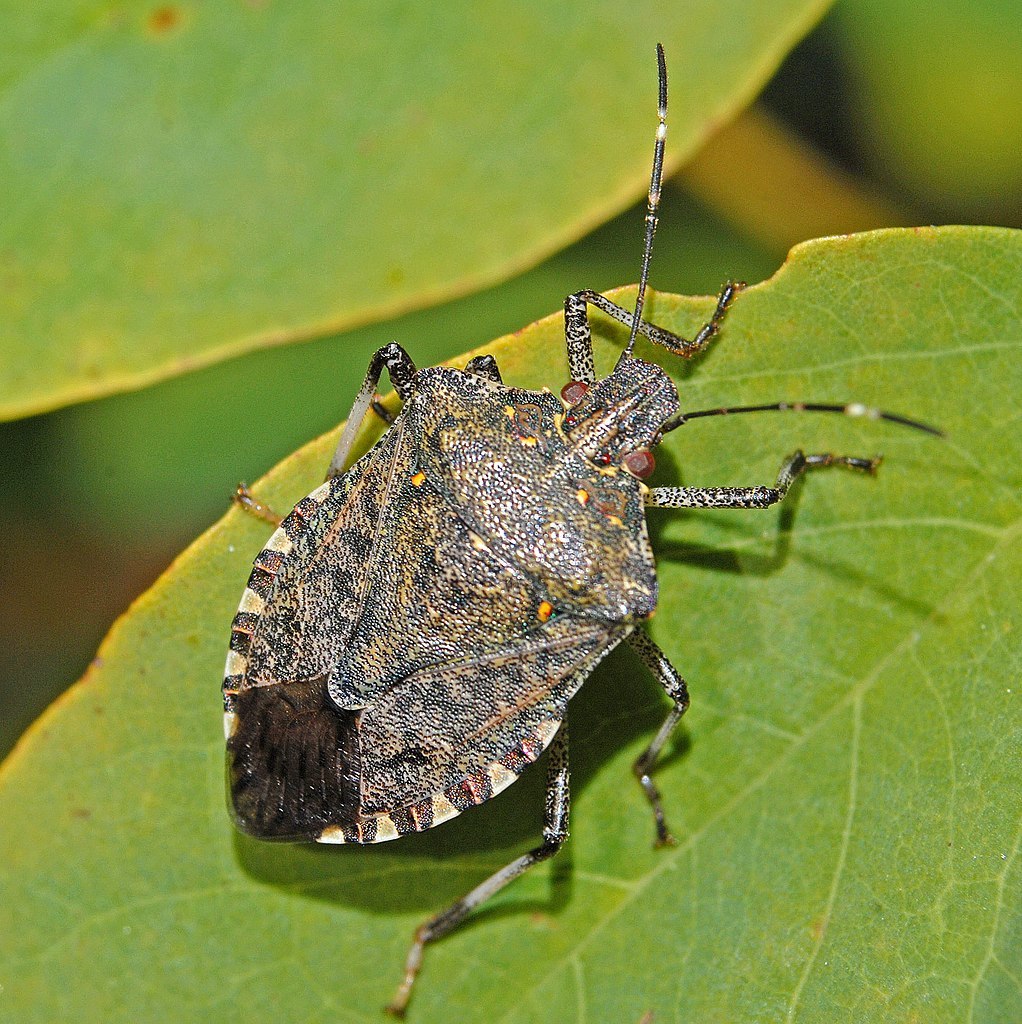 The unwelcome invader, a brown marmorated stink bug, often mistaken as Stinky Martin © Hectonichus
The unwelcome invader, a brown marmorated stink bug, often mistaken as Stinky Martin © Hectonichus
“I first became aware of it when one of my students, Ivan Šapina, noticed them in a cellar in Rijeka in the winter of 2017. He brought it to me, we identified it and wrote a paper about it. The following spring, they were all over Croatia. As a newcomer, it simply does not have the predators and parasites here that has been regulating Smrdljivi Martin over many years in our balanced ecosystem. They now greatly outnumber Smrdljivi Martin, Smrdljivi Greta and all other native species.”
“It's really difficult to tell the difference between these newcomers and Smrdljivi Martin,” says Lucija, explaining the reason for Martin getting cursed more frequently over recent years. “I'm not sure these differences could be so easily spotted with the naked eye. There are differences in their antennae and in the pattern of their wing membrane. Both bugs are brown in colour, but on the invasive species, the central part of the shield area of their body is completely marmorated - it has a marbled appearance. Smrdljivi Martin doesn't have that uniformly marbled appearance.”
If you do encounter any shield bugs entering the home this year, it's worth remembering that they are relatively harmless and are not coming inside to start a family (Stinky Martin doesn't lay its eggs until late Spring, and does so outside, on the leaves of plants). And, if you see several on your drying sheets, it's likely a false accusation to blame Stinky Martin. Martin already carries the burden of the unpleasant name we've given them, perhaps they deserve a break? Unlike the annoying newcomer on the washing line, Stinky Martin has as much right to be here as you or me.
For the latest travel info, bookmark our main travel info article, which is updated daily.
Read the Croatian Travel Update in your language - now available in 24 languages.
Oldest Domesticated Dogs In Croatia From 7500 Years Ago
November 3, 2020 - Croatia is well known as a dog-loving country, but just how long have there been domesticated dogs in Croatia? The oldest evidence is 7500 - 8000 years old
A new study published in the scientific journal Science ‘Origins and genetic legacy of prehistoric dogs’ has revealed fascinating details about the history of dogs, their origins and their co-existence with man. Lead by scientists from the University of Oxford, the Francis Crick Institute and the University of Vienna, four experts on Dogs in Croatia also participated: Dr. Sc. Dragana Rajković (Archaeological Museum, Osijek), Ph.D. Daria Ložnjak Dizdar (Institute of Archaeology Zagreb), Ph.D. Maja Pasarić (Institute of Ethnology and Folklore Research, Zagreb) and Dr. Sc. Mario Novak (Institute of Anthropology, Zagreb).
The study shows that around 11,000 years ago, at least five major historical dog breeds were separated and dispersed around the world. These breeds were all descended from a now-extinct species of wolf that was alive during the last ice age. These five dog breeds are the forefathers of today's domesticated dogs in Croatia, and everywhere else.
In an interview with Vecernji List, Dr Mario Novak explained some of the study's findings. He said that canines in Europe from the Mesolithic and Neolithic periods, including dogs in Croatia, appear to originate from two very different populations, one associated with Middle Eastern dogs and the other with Siberian dogs. Research has shown that over the last 10,000 years these early breeds have mixed and created the dogs as we know them today.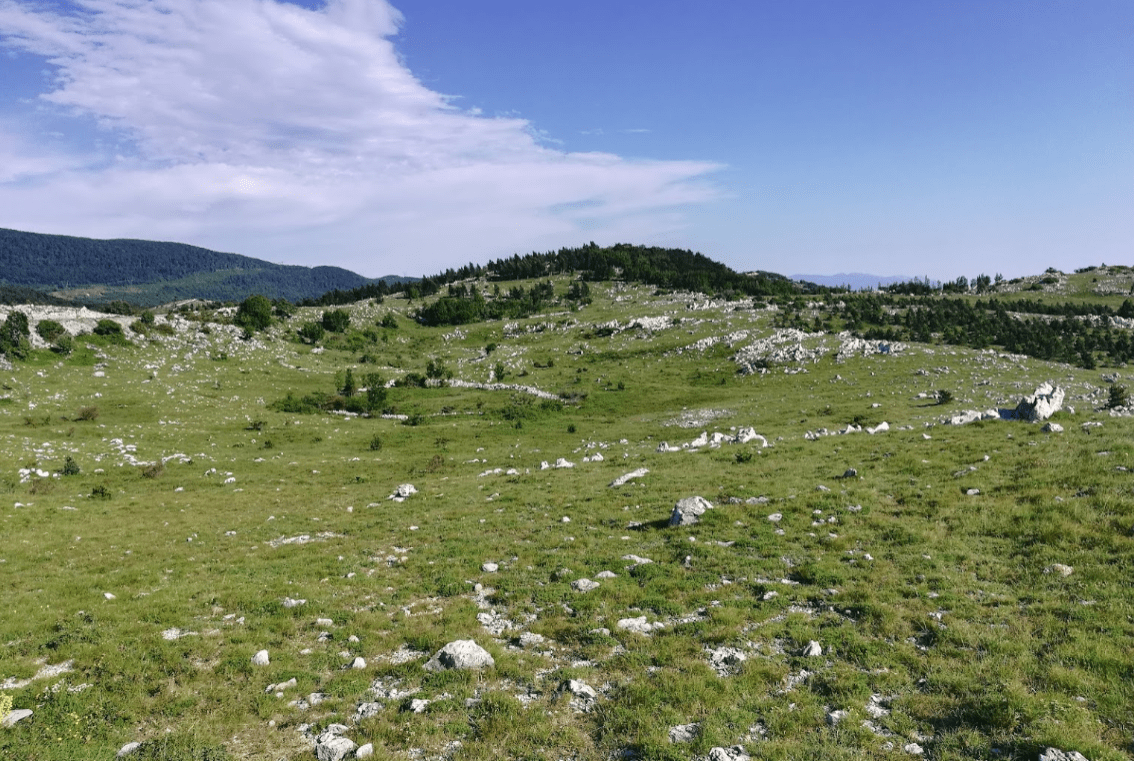 The archaeological site where evidence of the oldest domesticated dogs in Croatia was found is directly to the east of the modern city. You pass by the area of this former Neolithic settlement when you travel between the city and Zadar airport © Wikipedia
The archaeological site where evidence of the oldest domesticated dogs in Croatia was found is directly to the east of the modern city. You pass by the area of this former Neolithic settlement when you travel between the city and Zadar airport © Wikipedia
In their current forms, today's humans have existed for more than 40,000 years and dogs for about 14,500 years. The oldest evidence of modern domesticated dogs in Croatia come from remains found near Zadar. They have been dated to between 7500 and 8000 years old. There are six breeds of dogs that are today recognised as being indigenous to Croatia - Croatian sheepdog, Dalmatian, Istrian Coarse-haired Hound, Istrian Shorthaired Hound, Posavac Hound and the Tornjak. The vast majority of modern dog breeds originated over the last 200 years, so it is not clear if the oldest remains of dogs in Croatia are related to the indigenous breeds of today's dogs in Croatia.
“The question of why man and dog decided to coexist together is still not fully explained,” said Dr Novak to Vecernji List. “The relationship between man and dog is a very complex issue - this relationship is not one-way and most likely arose for mutual benefit, i.e. people realized the benefit they get from dogs and vice versa. The process most likely began about 25,000 years ago, and according to archaeological evidence, the process could have been completed approximately 14,500 years ago.”
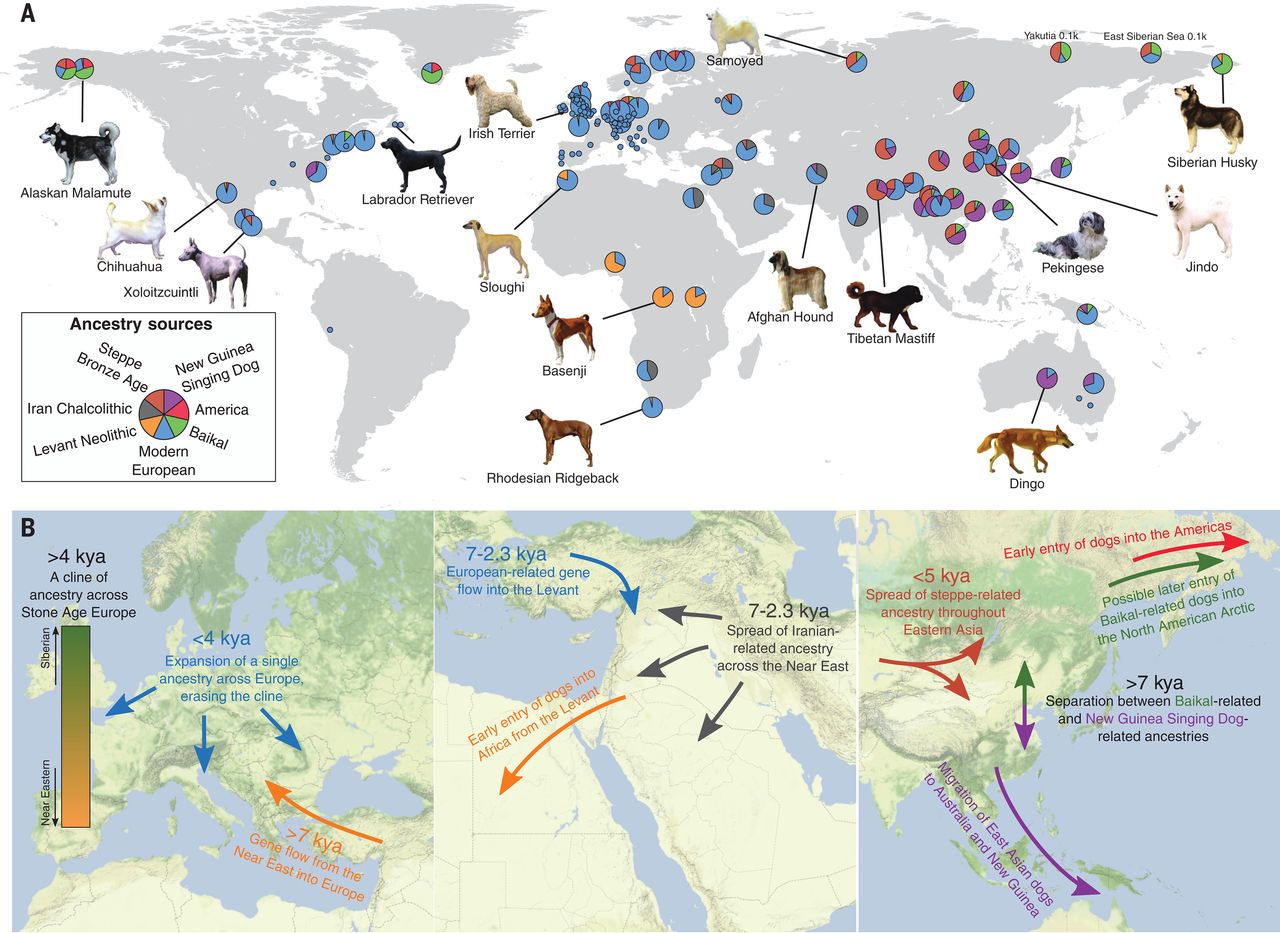 Graphic explaining ancestry of global dogs today, from the study
Graphic explaining ancestry of global dogs today, from the study
Dr Novak stated that the oldest evidence of modern domesticated dogs in Croatia comes from remains found in the Early Neolithic layer of the Crno vrilo archaeological site near Zadar. A fragment of the dog's lower jaw and two teeth from this site were dated to be approximately 7500-8000 years old. The ancient genomes of dogs in Croatia were sequenced for the first time in the Science journal study. One is from the Aljmaš - Podunavlje archaeological site, a Copper Age settlement (around 2600-2400 BC), the other from the site Sotin - Srednjea field, an older Copper Age settlement (around 3000-2900 BC).
For the latest travel info, bookmark our main travel info article, which is updated daily.
Read the Croatian Travel Update in your language - now available in 24 languages
VIDEO: Large Poskok Vipers Seen and Filmed in Vodice
October 26, 2020 – One of the largest Poskok vipers has been spotted in the area around Vodice, another was filmed hanging from a tree
Autumn in Croatia is the time of harvest, when the land gives up its bounty in preparation for winter and spring renewal. Those taking part in the harvest near the Dalmatian town of Vodice are sure to be extra vigilant over forthcoming days as local media has reported sightings of poskok vipers in the local.
One local resident detailed to infovodice.com that they had seen a specimen of almost 100cm in length. This is the maximum size an adult can reach (they are usually only around 85cm). Another of the poskok vipers was filmed hanging from a tree.
Vipera ammodytes is known as the poskok in Croatia. This species of viper is only found in southern Europe and parts of the Middle East. Although commonly called the sand viper, it actually prefers to live on dry, rocky hillsides with sparse vegetation, although it can be found on the edges of woodland and in woodland clearings.
The most northerly regions in which poskok vipers can be found are southern Austria, north-east Italy and Slovenia. They can be found as far east as Georgia, Syria and eastern Turkey. They are most commonly found within the countries of the Balkan peninsula.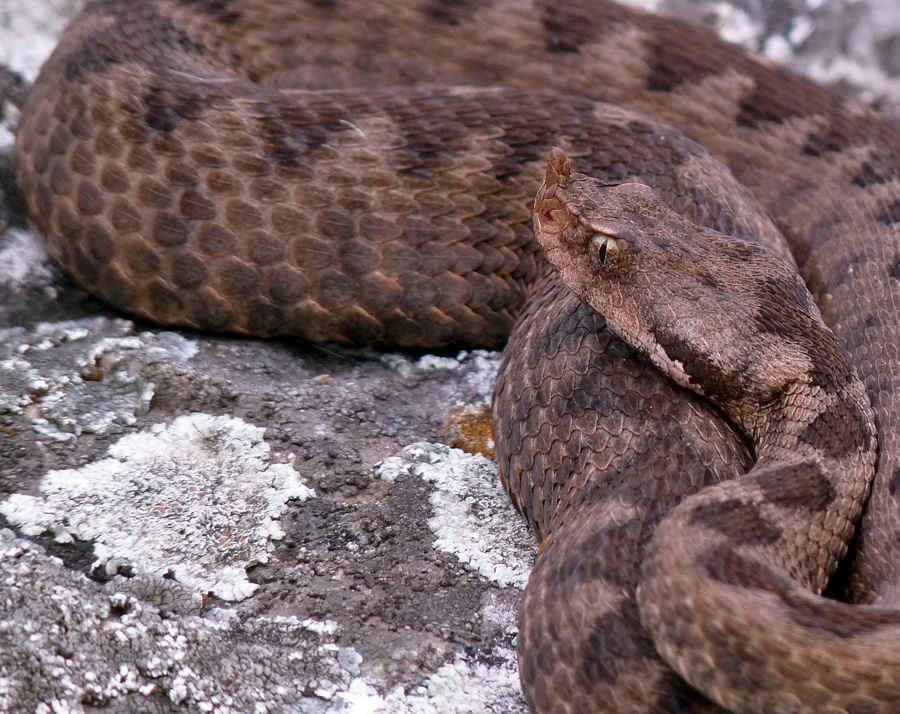 © Plamen Grigorov
© Plamen Grigorov
In Croatia, it's possible to find them living throughout Dalmatia and Istria, on the islands of Krk, Pag, Vir, Ugljan, Pašman, Korčula, Hvar, Brač and Mljet and in the continental regions of Lika, Medvednica, Žumberak, Banovina, Kordun, Gorski kotar, Kalnik, Zagora and Hrvatsko Zagorje.
Poskok vipers are a protected species in Croatia. Although they carry the deadliest venom of any snake to be found in Europe, they do not usually attack people unless provoked. However, they can be provoked unwittingly.
Depending on the region and the temperature, in the autumn months, the snakes can climb into trees. They do so to keep warm and to hunt for birds which, alongside small mammals and lizards, form the base of their diets. They hunt larger prey by first biting with their venom, then tracking the poisoned prey until it succumbs to the bite.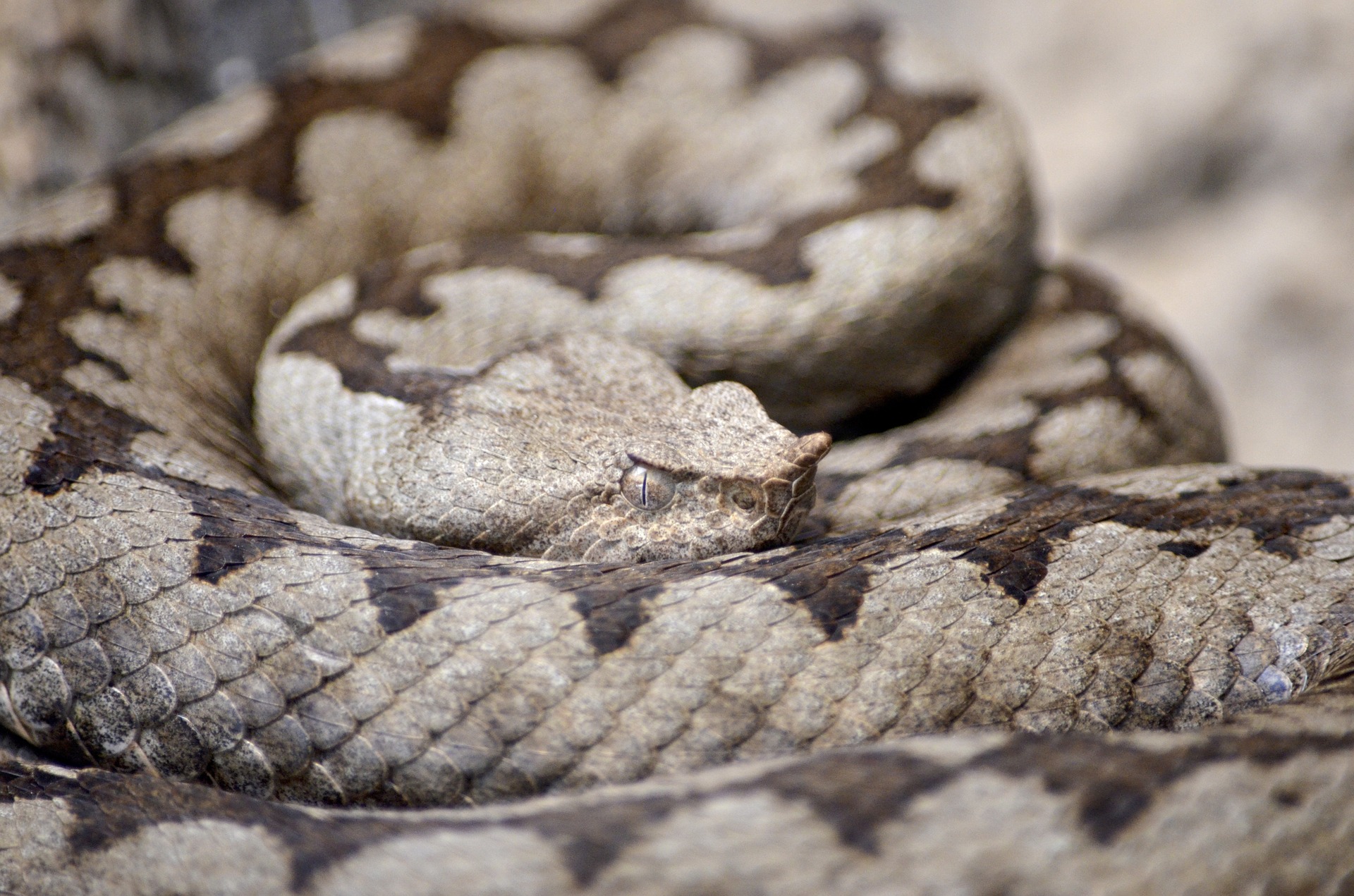 © Andrea Bohl
© Andrea Bohl
People are at particular risk to the vipers while they are in the trees as they can unknowingly walk close enough to the snake to make it feel threatened. Between August and the end of October, female poskok vipers give birth.
Poskok vipers can react unpredictably when they feel they are in danger. Some remain motionless and hiss loudly, some hiss and then flee, while still others will immediately attempt to bite. It is this unpredictability that gives poskok vipers their Croatian name – poskok meaning 'jumping' snake. The snake doesn't actually jump, but it can strike and bite faster than any other European snake. It coils itself over the back of its body and then throws its front towards its victim and has a considerable reach when doing so, of up to 40 centimetres.
On average, bites from poskok vipers account for around 25 hospitalisations each year in Croatia. Deaths occurring as a result of a bite are these days extremely rare. Although the snakes can be mistakenly disturbed in the autumn, the most common period for poskok bites on humans in Croatia is actually between May and June. The venom of poskok vipers is used to make antidote serum used to treat bites from all European vipers. Poskok vipers are farmed in some parts of Europe specifically for this purpose.
For the latest travel info, bookmark our main travel info article, which is updated daily.
Read the Croatian Travel Update in your language - now available in 24 languages.
Vukovar Student Becomes Croatia's First Animal Rights Lawyer
October 2, 2020 - Ivana Kramer from Vukovar became Croatia's first animal rights lawyer after graduating from the Faculty Of Law in Osijek
Ivana Kramer from Vukovar has become Croatia's first animal rights lawyer. She did so after graduating from the Faculty Of Law in Osijek, having received her diploma on September 23. The Faculty Of Law in Osijek is the only one in Croatia that has an elective course in animal rights.
In a recent interview with Vecernji List's Suzana Lepan Štefančić, Ivana explained that her desire to become Croatia's first animal rights lawyer stemmed from always having been around animals. “I have three dogs,” she said, in explaining her choice of the elective course in animal rights, “and my mother Željka adopts and helps abandoned animals.”
Some of the animals that Ivana's mum Željka looks after in Vukovar. Photos from the Facebook of Željka Kramer.
Ivana commuted to the Faculty Of Law in Osijek for five years in order to complete the course, choosing to stay living at home in Vukovar rather than move to the Slavonian capital. She says she would ideally like to stay in Vukovar to begin working in this field of law.
Her elective course in animal rights was undertaken in the final year of her studies and was the step that propelled her to the status of Croatia's first animal rights lawyer. During this final year, she researched the Animal Protection Act, which was implemented in 2017, with an emphasis on the situation in the Osijek-Baranja and Vukovar-Srijem counties. Her research included dog shelters in Vukovar and Osijek, where she occasionally volunteers.
For the latest travel info, bookmark our main travel info article, which is updated daily.
Read the Croatian Travel Update in your language - now available in 24 languages


